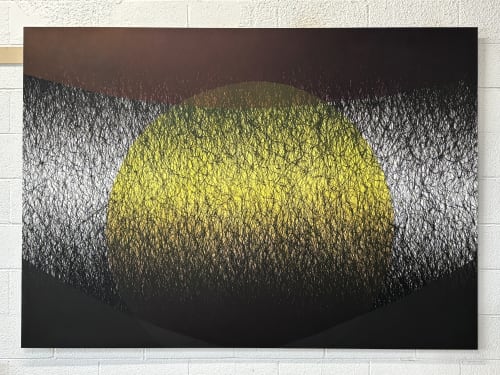“[A]ll molecules repeat the patterns of one another till complex new ones are formed.
They make others like themselves and a new dance starts.”
—Richard Feynman, The Value of Science (1955)
“The sun is new each day.”
—Heraclitus
Patterns and movement: Tandava, the eternal dance. Nothing is permanent, nothing is fixed; we never walk through the same river twice. Atoms and energy vibrate at different frequencies, manifesting one form or another. We believe in our sense of self and that our bodies are discrete entities, concrete realities fixed in time and space, but this is in part an illusion. Reality is a shape-shifting phenomenon, and we are mere atoms with consciousness in this dynamic chimerical universe. These are some of the ideas and insights that fuel the intricate play of material, process, pattern and form in the exquisite artworks of Sandeep Mukherjee.
I spent a morning with the artist in his studio, an industrial space filled with his large-scale paintings and sculptures that hang from the ceiling, rest on the floor, or are mounted on the walls. During our long conversation, I asked him what it was he was trying to do, what he hoped to convey in his work.
“I want to create moments of joy. I want to experience the joy of discovery and of making things, and share that joy with others. My work comes out of curiosity, out of a ‘what if’ state of mind. These objects that I make are embedded with my experience of life. I want my audience to be deeply affected by my work, to be present in that moment, and to be changed from the experience.”
He speaks with great energy, his words come quickly, his passion and conviction expressed in his animated manner.
Mukherjee was born in India. His earliest memories are of being swaddled in his mother’s saris. His young eyes gazing through the shifting layers of vivid colors and patterns in the beautiful fabrics left a deep impression on him: they are part of who he is and inform his work. “When I first saw Mark Rothko’s paintings, I thought to myself, the color gradients of my mother’s saris are more beautiful than these!”
He was very close to his grandmother, who was blind. “As a child, we would spend time together, walking through our garden, and she would touch the plants, feeling the edge of a leaf, describing the contour of its edge. Seeing through touch. The pattern of the leaf’s shape would become the cadences of classical Indian music in her mind. In turn, I would describe the sensations and feelings of the colors to her. This experience affected me deeply.”
When he came to the United States at 22, he studied engineering at UC Berkeley. While working toward a master’s degree in engineering, he took part in the COBE satellite project, analyzing the cosmic radiation left over from the Big Bang. “When I saw the patterns of this energy on the computer screens from the beginning of the universe, it had an enormous impact on me. To know that we are made up of atoms and energy—and that everything we see is constantly in movement, in process, always changing—shaped my philosophical perspective. After a short period of time working in the science world, I realized I wanted to be a creative artist. So I went back to school to study art.” In his art, the boundaries of self are fluid. His work and the way he uses materials are all fused within his philosophical viewpoint that existence is an ever-changing process of folding and unfolding in intricate patterns.


